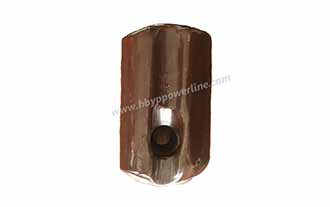It is obvious that if the overhead power line is not properly insulated from its supporting pole/tower, the current will flow through the pole/tower to the ground, which will also become dangerous. Of course, in this case, the power cord will not even work! Therefore, the overhead power line is always supported on the insulator installed on its support pole/tower.
Overhead line insulators should have the following characteristics:
High mechanical strength, can bear conductor load, wind load, etc.
High resistance to minimize leakage current
The relative dielectric constant of the insulating material is high, so the dielectric strength is high
High puncture strength and arcing ratio
The most commonly used material for overhead line insulators is porcelain. But sometimes glass, talc, and other special composite materials can also be used.
In order to make the power line run successfully, it is very important to choose the insulator correctly. There are several types of overhead line insulators. The most commonly used types are:
Pin insulator
Suspended insulator
Strain insulator
Hook and loop insulator
Pin insulators are commonly used in power distribution systems with voltage levels up to 33 kV. They are fixed on the cross arm of the pole to carry the power cord. The pin insulator has a groove at the upper end to accommodate the conductor. The wire passes through the groove and is bound and fixed with the same wire as the wire.
Needle insulators are usually made of porcelain, but in some cases, glass or plastic can also be used. Since pin insulators are almost always used in the open air, proper insulation during rain is also an important consideration. The wet lead insulator can provide a path for current to flow to the electrode. To overcome this problem, needle insulators are designed with canopies or petticoats. Above the operating voltage of 33kV, the pin insulator becomes too bulky and uneconomical.
Insulators must be properly designed to withstand mechanical and electrical stress. The electrical stress on the insulator depends on the line voltage, therefore, an appropriate insulator must be used according to the line voltage. Excessive electrical stress will break down the insulator through arcing or breakdown.
Flashover: In insulator flashover, discharge is generated by forming an arc on the line conductor and the insulator pin (connected to the cross arm). The discharge skips the air around the insulator with the shortest distance. When an arc occurs, the insulator will continue to work according to its design capacity, unless the insulator is damaged by overheating.
Piercing: If the insulator is pierced, a discharge will occur from the conductor to the pin through the insulator. Porcelain (or insulator material) of sufficient thickness must be provided to avoid breakdown. When this type of failure is involved, the insulator will be permanently damaged.
A safety factor of insulator: The ratio of breakdown strength to arcing voltage is called the safety factor. It is desirable to have a high safety factor value so that arcing occurs before piercing the insulator. For pin insulators, the safety factor is about 10.

Suspension Insulators
As mentioned above, the pin-type insulator is too large and uneconomical when it exceeds 33 kV. Therefore, for voltages higher than 33 kV, suspension insulators are used. Suspension insulators are composed of many porcelain plates, which are connected to each other by wire-shaped metal chains. The wire is suspended at the bottom end of a suspension column fixed on the cross arm of the tower. Each disc in the suspension insulator string is designed for a low voltage, such as 11 kV. The number of discs in the string depends on the operating voltage. Suspended insulators are the first choice for transmission lines.
lEach unit of the optical disc is designed for low voltage, such as 11 kV. Therefore, according to the operating voltage, a required number of disks can be connected in series to form an insulator string suitable for a specific voltage.
If any disc in the insulator string is damaged, it can be easily replaced. There is no need to replace the entire string.
In the case of increased demand for lines, the line voltage can be increased by adding the required number of discs in the insulator string, and the additional insulation required for the increased voltage can be easily provided.
Since the wires are suspended by suspension wires, they extend below the grounding cross arm of the tower. This arrangement provides partial protection against lightning.
The suspension device provides greater flexibility for the production line. The suspension insulator can swing so as to occupy the position with the least mechanical stress.
At the ends or corners or sharp curves of the transmission line, the transmission line bears a large tensile load. In order to withstand greater tension, strain insulators are used at dead or sharp corners. For high-voltage transmission lines, anti-fouling insulators consist of suspension insulator components. In this case, the suspension wire is placed horizontally and the insulating disk is on a vertical plane. Two or more suspended strings can be assembled in parallel to withstand greater tension. For low voltage lines (less than 11 kV), hook-and-loop insulators are used as strain insulators.
Shackle insulators are used as strain insulators in low-voltage distribution lines. Hook-and-loop insulators can be used in both vertical and horizontal directions and can be directly fixed on a pole or cross arm by bolts. However, after increasing the use of underground cables for distribution purposes, the use of such insulators is decreasing.
Some other types of insulators are post insulators, glass insulators, polymer insulators, long pole insulators, post insulators, etc.
+86 319 878 9350
+86 156 1304 7999
+86 319 878 9350
NanYan, DongHuan Road, Shahe, Hebei China
Copyright © Hebei Yipeng Line Equipment Co., Ltd. All Rights Reserved. | Sitemap Powered By 
